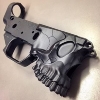evtSmtx
Member
to $150?
if this is the wrong forum, steer me where I should have posted.
thanks
if this is the wrong forum, steer me where I should have posted.
thanks
Last edited:

Actually, that's backward. There's no reason for a billet receiver to be stronger than forged UNLESS you're adding a lot of thickness/weight to strengthen it. Which is easier to do when you're cutting a few proprietary pieces out of billets instead of making forging dies to produce tens of thousands.less expensive, but not quite as strong
If we're strictly talking about aluminum receivers, there are different alloys.
And some are milled from a single piece of billet (more expensive, but stronger) or forged and milled (less expensive, but not quite as strong).
90% of the time i think higher priced stuff is justified due to differentiation in features, quality, attention to detail etc. but imho your run of the mill stripped AR lowers are in the 10% where it's really just protecting a brand name.
If you're comparing forged lowers, the difference in price is roll mark.
Billets are all over the map, and with them you are also looking at varying features and aesthetics. Billet is universally more expensive because they require a great deal more machining, not because they are functionally superior.
But for a VERY If we were talking steel, the forged piece would be stronger, but aluminum doesn't realize the same benefits of grain structure alignment.
My years in aviation says otherwise. There are parts that must be made from forgings so they have the grain flow to do the job
